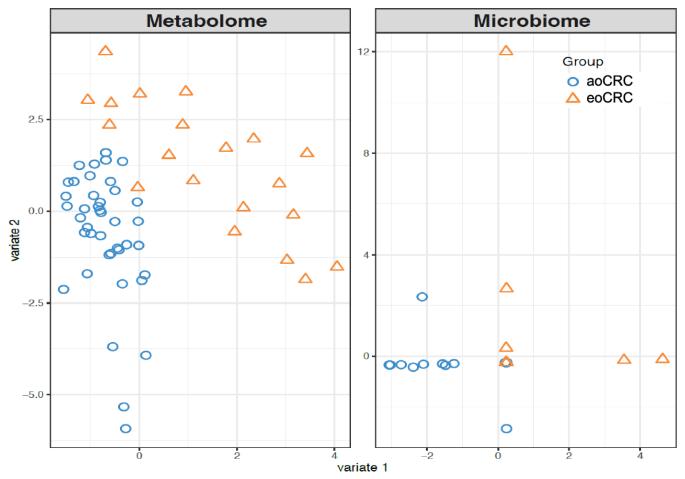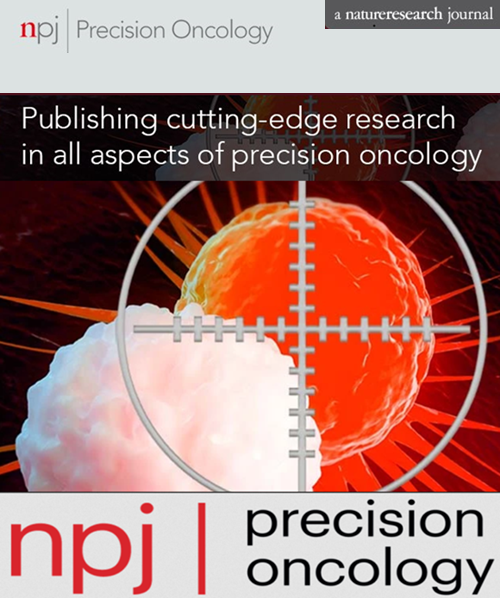多组学机器学习研究早期结直肠癌中宿主与微生物组的相互作用
IF 6.8
1区 医学
Q1 ONCOLOGY
引用次数: 0
摘要
早发性结直肠癌(eoCRC)的发病率正在上升,而其发病机制尚未完全明了。我们假设,利用成对的组织微生物组和血浆代谢组特征进行机器学习,可以发现 eoCRC 和平均发病期 CRC(aoCRC)之间不同的宿主微生物组关联。I-IV 期 CRC 患者(n = 64)被分为 eoCRC(年龄≤ 50,n = 20)或 aoCRC(年龄≥ 60,n = 44)。对肿瘤组织进行了非靶向血浆代谢组学研究和 16S rRNA 扩增子测序(微生物组分析)。我们利用DIABLO(Data Integration Analysis for Biomarker Discovery using Latent variable approaches for Omics studies),使用成对的多组学(微生物组学和代谢组学)数据构建了一个有监督的机器学习分类器,并确定了eoCRC特有的关联。此外,还进行了差异关联网络分析。在多组学降维分析中出现了独特的聚类模式。代谢组学分类器的AUC为0.98,而基于微生物组的分类器的AUC为0.61。循环相关技术突出了几种关键的关联。代谢物甘油和假尿苷(在aoCRC患者中含量较高)与副肠球菌和反刍球菌(在eoCRC患者中含量较高)呈负相关。胆固醇和木糖醇与红斑梭状芽孢杆菌(Erysipelatoclostridium)和欧杆菌(Eubacterium)呈负相关,而与酸性球菌(Acidovorax)呈正相关,酸性球菌在 eoCRC 患者中含量较高。网络分析揭示了几种代谢物不同的聚类模式和关联,如尿素循环代谢物和 Akkermansia 等微生物。我们的研究表明,多组学分析可用于研究 eoCRC 中宿主与微生物组的相关性,并展示了代谢组学分类器的生物标记潜力。eoCRC 中宿主-微生物组在尿素循环方面的独特相关性可能会为治疗干预提供机会。本文章由计算机程序翻译,如有差异,请以英文原文为准。

Multi-omics machine learning to study host-microbiome interactions in early-onset colorectal cancer
The incidence of early-onset colorectal cancer (eoCRC) is rising, and its pathogenesis is not completely understood. We hypothesized that machine learning utilizing paired tissue microbiome and plasma metabolome features could uncover distinct host-microbiome associations between eoCRC and average-onset CRC (aoCRC). Individuals with stages I–IV CRC (n = 64) were categorized as eoCRC (age ≤ 50, n = 20) or aoCRC (age ≥ 60, n = 44). Untargeted plasma metabolomics and 16S rRNA amplicon sequencing (microbiome analysis) of tumor tissue were performed. We fit DIABLO (Data Integration Analysis for Biomarker Discovery using Latent variable approaches for Omics studies) to construct a supervised machine-learning classifier using paired multi-omics (microbiome and metabolomics) data and identify associations unique to eoCRC. A differential association network analysis was also performed. Distinct clustering patterns emerged in multi-omic dimension reduction analysis. The metabolomics classifier achieved an AUC of 0.98, compared to AUC 0.61 for microbiome-based classifier. Circular correlation technique highlighted several key associations. Metabolites glycerol and pseudouridine (higher abundance in individuals with aoCRC) had negative correlations with Parasutterella, and Ruminococcaceae (higher abundance in individuals with eoCRC). Cholesterol and xylitol correlated negatively with Erysipelatoclostridium and Eubacterium, and showed a positive correlation with Acidovorax with higher abundance in individuals with eoCRC. Network analysis revealed different clustering patterns and associations for several metabolites e.g.: urea cycle metabolites and microbes such as Akkermansia. We show that multi-omics analysis can be utilized to study host-microbiome correlations in eoCRC and demonstrates promising biomarker potential of a metabolomics classifier. The distinct host-microbiome correlations for urea cycle in eoCRC may offer opportunities for therapeutic interventions.
求助全文
通过发布文献求助,成功后即可免费获取论文全文。
去求助
来源期刊

NPJ Precision Oncology
ONCOLOGY-
CiteScore
9.90
自引率
1.30%
发文量
87
审稿时长
18 weeks
期刊介绍:
Online-only and open access, npj Precision Oncology is an international, peer-reviewed journal dedicated to showcasing cutting-edge scientific research in all facets of precision oncology, spanning from fundamental science to translational applications and clinical medicine.
 求助内容:
求助内容: 应助结果提醒方式:
应助结果提醒方式:


